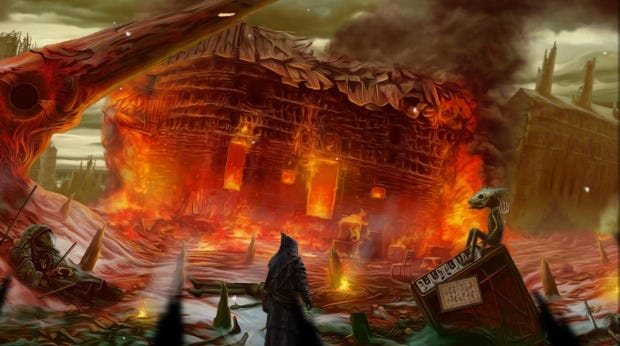Wot I Think: Tormentum - Dark Sorrow
Giger Counter
The two sides have finally met in the middle! About ten years back, as adventure gaming continued to trundle along before its recent renaissance, hidden object games became a hugely popular form of “casual game” (a vile term that needs to be removed from our snobbish vocabulary). With time, the two have been gradually creeping toward one another. The latter shedding its spot-the-difference origins for more puzzle-focused, story-led design, and the former simplifying itself to single-click interaction for a larger audience on tablets. In the genuinely interesting Tormentum: Dark Sorrow [official site], the two finally meet in the middle. Here's wot I think.
While a mixture of haughtiness and confused indifference has led many long-time games players to sniffily ignore everything that’s come from the “casual” (eurgh) side of things, there have been some really splendid – and often extremely beautiful – adventures from the likes of Big Fish. Most especially the Drawn series, which tell spellbinding tales of magical paintings, combined with various puzzles to solve along the way. Tormentum looks and plays like a darker, more sophisticated version of that lineage, despite being from entirely other origins. And most of all, Tormentum looks incredible.
You play as a grimly hooded figure, in some sort of nightmarish world that looks as if Giger provided character designs for The Labyrinth directed by Guillermo del Toro. Imprisoned in a dank castle, you must escape and make your way to a distant land, via the collection of inventory items, puzzle pieces, and solving traditional puzzles, while encountering the most peculiar cast of characters since Zeno Clash. There are, at various points, choices to be made that have a moral (and mortal) impact on your story, as you attempt to untangle the mystery of your purpose.
What you actually play is perhaps more room escape than point and click adventure, but with lots of nipping back and forth between many, many scenes in each of the three acts, gathering items needed to unlock new doors, or meet the whims of the monstrosities within. And, while I’m doing my best to convince you this is something worth giving a look, I have to concede that there are indeed sliding tile and Klotski puzzles. But hey, at least there’s not a torn letter to restore.
What’s nice about the trad puzzles here is that they often feel slightly more relevant than their usual crowbarring into scenes. They’re still obtuse, certainly, but fortunately never needlessly difficult. If anything, they’re all slightly too easy, or at least too familiar for someone who’s ploughed their way through these things since the early 90s.
Inventory puzzles are better, although again, very simple. It’s all more about the satisfaction of the continuous chain of solution and reward, a steady, pleasing flow that kept me entertained without ever leaving me stuck.
What’s truly outstanding here is the sound and art. The sound is more subtle, the music haunting strains and mechanical grinds, suitably forgettable but atmospheric at the time. The art is just extraordinary. Clearly influenced by Giger and (I’ve since learned) Beksiński, the gothic horror is phenomenally detailed and elaborate, and so incredibly often breathtaking.
The cost of such art is character animation. Your main character is static in each scene, the cursor doing the walking for you, and while much else is in motion, it’s relatively basic. Although, in fairness, anything else would have taken lifetimes. It’s also a shame that it’s in 4:3, despite moving the mouse from left to right giving a slight movement each way. They’d clearly fit in a more pleasing widescreen, so it’s a bit odd that they don’t – it’d look even more impressive if it did. And as much as I admire it, there’s something oddly low-res about it.
But wow, there’s so much art here. Dozens and dozens of scenes have intricate backgrounds and stunning creature design. In one section you visit an ancient building that houses a gallery of art by a painter. Inside are fifty or so unique pictures to look at close-up, on top of everything else in the game. This is all the work of developer Piotr Ruszkowski, and I can only assume the gallery doubles up as a showcase for his portfolio.
Tormentum, in being the game that overlaps the two opposite approaches to adventure gaming, does end up feeling a bit woolly as a result. It’s very simple to complete, and your interaction with the world is fairly primitive. And yes, sliding tile puzzles. But it also has a deeper story and much darker tone than you’d expect from the casual market. Choices you make (and let’s be clear, there are about eight binary decisions throughout) genuinely affect the story (but again, in very minor ways), and there are different endings for how you went about things. (The best motive for reaching the “good” ending is you’re spared some dreadful shouty metal over the credits.) I could go deeper into how the game’s interpretations of “good” and “bad” are peculiarly conservative, but I think it would perhaps be rather over-analysing things.
I rather enjoyed it.













